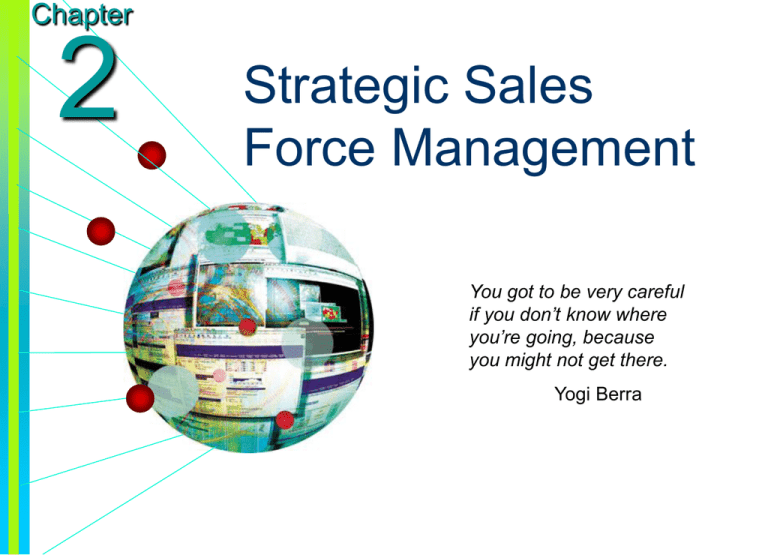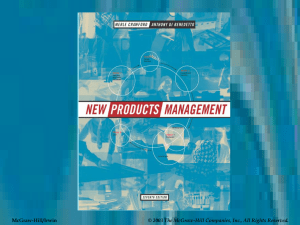
Chapter
2
2-1
Strategic Sales
Force Management
You got to be very careful
if you don’t know where
you’re going, because
you might not get there.
Yogi Berra
Copyright © 2003 by The McGraw-Hill Companies, Inc. All rights reserved.
Figure 2-1:
A company’s
complete
marketing
system
2-2
Macroenvironmental
forces:
Demography
Economic conditions
Sociocultural factors
Political-legal factors
Technology
Competition
Company’s marketing mix:
Suppliers
Marketing
intermediaries
Product planning
Price structure
Distribution system
Promotional activities
Marketing
intermediaries
Nonmarketing resources in the firm:
Production
Financial
Personnel
Copyright © 2003 by The McGraw-Hill Companies, Inc. All rights reserved.
Public image
Research and
Development
Location
The
market
2-3
The Marketing Concept
A philosophy:
Achieving organizational goals depends
on the firm’s ability to identify the needs and wants of a
target market, and then to satisfy those needs and
wants better than the competition does.
Based
on three fundamental beliefs
Company planning and operations should be customer or
market oriented.
Marketing activities in a firm should be organizationally
coordinated.
The goal of the organization should be to generate
profitable sales volume over the long run.
Copyright © 2003 by The McGraw-Hill Companies, Inc. All rights reserved.
Evolution of
Marketing Management
Production
orientation
Age of the hard-sell.
Marketing
orientation
Focus on mass-producing a limited variety of products for
as little cost as possible.
Sales
2-4
orientation
The marketing concept first emerges.
Relationship
orientation
A natural extension of the marketing-orientation stage.
The buyer and seller commit to doing business over a
long time.
Copyright © 2003 by The McGraw-Hill Companies, Inc. All rights reserved.
2-5
Figure 2-3
How do these
selling styles
depicted in this
1927 cartoon
relate to the
four stages in
the evolution
of marketing
management?
Copyright © 2003 by The McGraw-Hill Companies, Inc. All rights reserved.
Relationship Marketing:
Four key issues
Open
communication
Empowering
Customers
Working
Total
employees
and the planning process
in teams
quality management
Copyright © 2003 by The McGraw-Hill Companies, Inc. All rights reserved.
2-6
2-7
Teaching Teamwork
In
your opinion, which one of these (if any) would be
most effective at teaching a salesperson how to be an
effective member of a selling team?
Cooking class
Drum circle
Military exercise
Outdoor adventure
Ropes exercise
Copyright © 2003 by The McGraw-Hill Companies, Inc. All rights reserved.
2-8
Integrating…
…Marketing
and Sales
Marketing executives develop marketing strategy
Salespeople implement the strategy in the field
…Production
and Sales
Production makes what Sales sells
Close integration / accurate forecasts needed, or else…
Under-production dissatisfied customers
Over-production excessive, costly inventory
Copyright © 2003 by The McGraw-Hill Companies, Inc. All rights reserved.
2-9
Strategic Planning
Set
Objectives
Objectives are the broad
goals around which a strategic
plan is formulated.
Formulate
Strategies are the plans of
Strategies
action.
Tactics are the specific
activities that people must
perform in order to carry out
the strategy.
Copyright © 2003 by The McGraw-Hill Companies, Inc. All rights reserved.
Develop Tactics
2-10
Company StrategyMarketing Objectives and Strategy
Company
Objectives
Marketing
Earn 20% ROI
Strategy
Increase marketing share 10%
Objectives
Increase market
share 10%
Strategy
Increase share of customer business
Copyright © 2003 by The McGraw-Hill Companies, Inc. All rights reserved.
2-11
Marketing StrategySales Force Objectives, Strategy and Tactics
Marketing
Objectives
Sales Force
Increase market share 10%
Strategy
Objectives
Increase share of customer business
Increase share of
customer business
Strategy
Build long-term
customer relations
Tactics
Develop sales teams
Provide bonuses for greater customer share
Copyright © 2003 by The McGraw-Hill Companies, Inc. All rights reserved.
2-12
Strategic Trends
Internet
Selling
Multiple Sales Channels
Multiple Relationship Strategies
Transaction selling Consultative selling
In
this era of global warming, toxic waste, pollution, and
other concerns, marketing executives must act in a
socially responsible manner if they wish to succeed or
even survive.
Copyright © 2003 by The McGraw-Hill Companies, Inc. All rights reserved.
Customer Relationship
Management
CRM
2-13
practices
Involve a company-wide software application utilizing
advanced computer- and Internet-technology.
Aggregate all information about customers into a single
database.
Provide salespeople/customers access to timely and
relevant information.
Allow effective management of every aspect of the buyerseller relationship.
Require training
Only effective if salespeople embrace it and are willing to
use it.
Copyright © 2003 by The McGraw-Hill Companies, Inc. All rights reserved.





